Tire Buying Guides
Best price guarantee
Tire replacement coverage
24/7 roadside assistance
Easy returns

All-season, all-weather, winter tires…they all kinda sound the same. Winter is a kind of weather, right? And winter is a season, so shouldn’t all-season tires be able to handle winter driving with little trouble?
It might seem that way at first glance, and of course, all-season tires are far and away the biggest selling segment of the tire industry (for reasons that we’ll elaborate on in a moment). As versatile as all-season tires are, though, they just about always fall short of being able to get the job done effectively when there are a few inches of snow on the roads. The truth is that all-season tires are the best choice when you’re living in a mild climate, while all-weather tires are designed for enhanced grip and control in tough winter conditions. Winter tires, on the other hand, feature specialized designs that are purpose-built for challenging winter driving.
In this blog, we’re going to break all this down and get into some of the similarities and contrasts between all-season, all-weather, and winter tires as well as talking about some great premium tire choices in each category. Let’s get in there and get a closer look:

What are All-Season tires?
There’s a reason why all-season tires take up almost 60 percent of all tire sales in the United States. For most drivers, all-season tires are an excellent jack-of-all-trades solution, the Swiss Army Knife of tires. All-season tires are designed for:
- Long, even wear, often with excellent limited manufacturer’s tread life coverage and advanced tread formulations that deliver great wear properties
- Ride quality that’s refined and accommodating
- Low noise, with tread pitches that are acoustically tuned for a quiet ride by reducing wind noise around the tire and canceling certain frequencies and overtones
- Dependable traction in about every kind of road condition other than heavy snow, with a system of grooves that are designed to resist hydroplaning by diverting water away from the tire’s contact patch
- Steering response that’s light and direct
- Solid straight-line road manners, thanks to a continuous center rib in the tire’s tread blocks
- Cornering ability that’s capable and precise with shoulder blocks that are reinforced to resist tread squirm and deformation when going hot into a corner or around a curve
- Good high-speed stability, thanks to durable internal construction that usually includes a polyester casing, high-tensile steel belt package, and a nylon cap ply to hold it all together
Unsurprisingly, since all-season tires are such a popular choice, they’re available at every price point you can imagine, from spendy premium brand tires to more affordable tires from more obscure manufacturers. We’re going to take a look at some of the top-rated choices in all-season tires picked out by us here at the SimpleTire team:
Top all-season tire choices
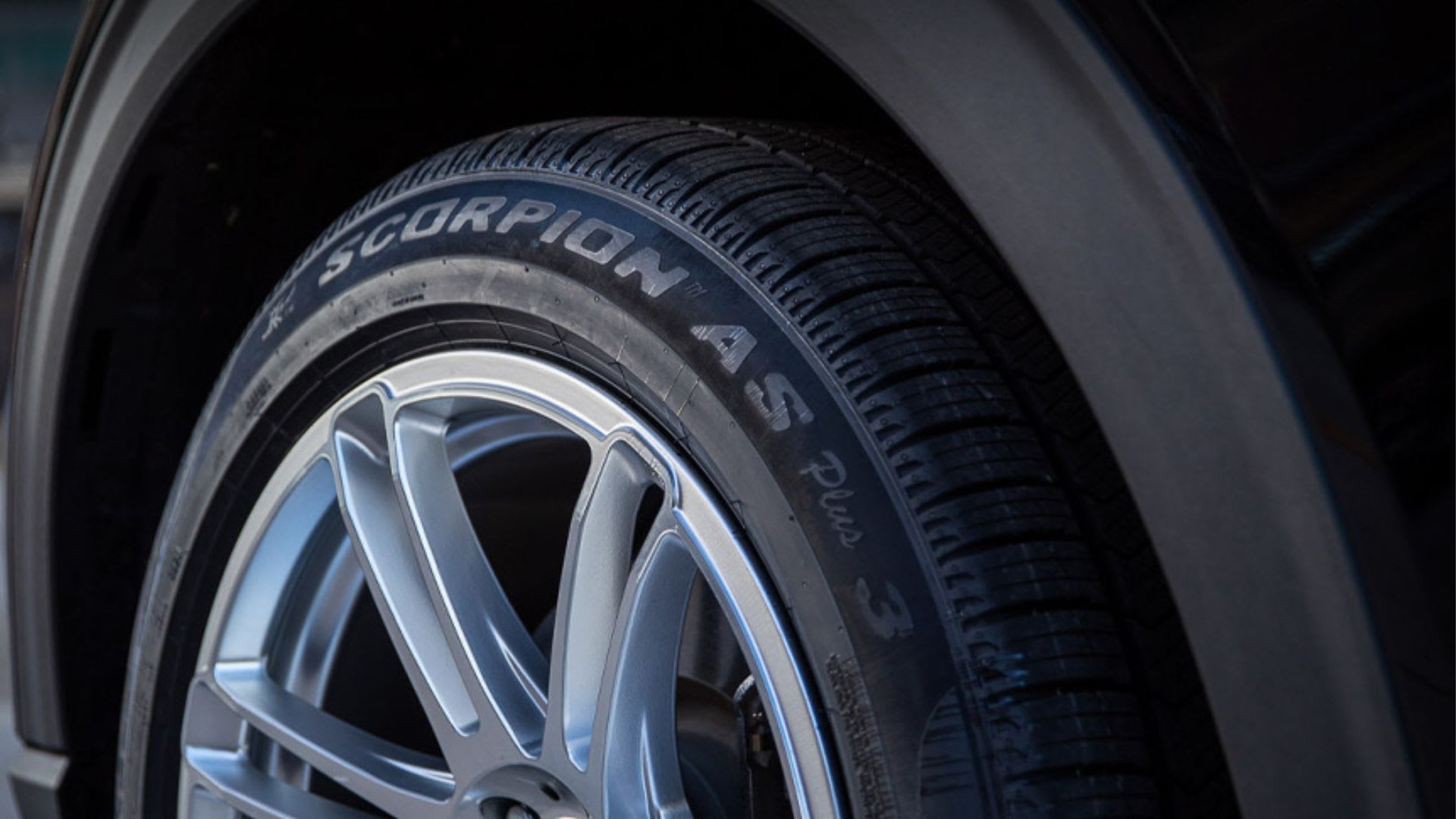
Here are a few of our top picks for premium all-season tires:
Pirelli Scorpion All Season Plus 3:
With the Scorpion All Season Plus 3, the Pirelli design team has put forward an all-season tire that’s designed for sharp performance as well as year-round versatility and ride quality. The Scorpion All-Season Plus 3 starts off with an advanced silica-rich tread compound that’s built to go the extra mile, with excellent wear properties and a marketed improvement in traction and braking on wet pavement. The Scorpion All Season Plus 3’s contact patch is redesigned and optimized to ensure the most rubber contact with pavement for improved braking, control, and long, even wear. Stability and road manners are top-notch thanks to its continuous center rib, which also helps with quick and accurate response to driver inputs. On the highway, the Scorpion All Season Plus 3 is dead-quiet with Pirelli’s Noise Canceling System, a layer of foam rubber that soaks up sound waves and overtones from the pavement as well as absorbing roughness and vibration for a quiet, serene ride. Another nice perk is the peace of mind that goes with Pirelli’s Run-Flat technology, a reinforced internal structure, and sidewall that allows a driver to go up to another 50 miles at 50 mph even in the event of complete loss of inflation pressure. In rainy weather, the all-season tread is ready with wide circumferential grooves, and angled and lateral grooves to help evacuate water from the tire’s contact patch and resist hydroplaning. On wet or snowy roads, a dense network of 3D sipes is designed to interlock and reinforce the tread’s stiffness while multiplying surface area and traction with hundreds of fine biting edges.
The Scorpion All Season Plus 3 helps cut emissions and fuel costs with a tread compound and design that are optimized for reduced rolling resistance. Handling gets a boost from internal construction and a shoulder design that is reinforced for extra rigidity, helping to avoid deformation and tread squirming during hard maneuvers and cornering. Pirelli covers the Scorpion All Season Plus 3 with a 70,000 mile limited manufacturer’s tread life warranty; it’s available in 31 sizes from 17 to 22 inches, making the Pirelli Scorpion Zero All Season Plus 3 a great fit for a wide range of vehicles. SimpleTire’s SimpleScore breakdown for the Scorpion All Season Plus 3 is impressive: 9.7 for traction, 9.4 for handling, and 9.8 for longevity, with an overall average SimpleScore of 9.6. SimpleTire’s price on the Scorpion All Season Plus 3 runs from $182.26/tire to $321.36/tire.
Bridgestone Turanza QuietTrack:
The Turanza QuietTrack is the preferred choice as factory original equipment for many luxury cars and CUVs. If you’re the kind of driver who puts a premium on a refined ride, low noise, and long tread life along with year-round performance, this could be the tire that checks all those boxes for you. Bridgestone’s engineers designed the Turanza QuietTrack from the ground up with durable internal construction and a long-lasting tread compound, helping to ensure stability and long wear. The internal construction details of the Turanza QuietTrack include a polyester casing with steel belts and a nylon cap overlay. Warranty coverage is exceptional; Bridgestone covers the Turanza QuietTrack with a best-in-class 80,000 mile limited manufacturer tread life warranty, which is enough for the SimpleTire team to give it an outstanding SimpleScore of 9.6 for longevity. The Turanza QuietTrack delivers dependable all-season traction and resistance to hydroplaning with a network of open shoulder slots, 3D sipes, and a network of circumferential and lateral grooves. In the traction category, the Turanza QuietTrack brings in a score of 9.7. We’re also impressed with the tire’s handling; it offers great road manners, steering response, and precise cornering of the Turanza QuietTrack, thanks to its tread technology, stiff shoulder, and sidewall, enough for a near-perfect SimpleScore of 9.9.
Maybe one of the most notable features of the Turanza QuietTrack, though, is its dead-quiet ride. It’s designed with non-chamfered grooves, an optimized tread pitch, and in-groove ridges, all breaking up and neutralizing resonance and road noise for a driving experience that’s amazingly peaceful and quiet. SimpleTire’s price on the Turanza QuietTrack ranges from $180.99/tire to $311.99/tire.
Continental ExtremeContact DWS06 PLUS:
With the ExtremeContact DWS06 Plus, Continental’s engineers were shooting for the best of both worlds – a tire that can offer exhilarating driving with UHP levels of traction, cornering, braking, steering response, and overall handling. That kind of performance lives alongside the dependable grip that can help you confidently get through all kinds of weather conditions year-round. The ExtremeContact DWS06 PLUS sweetens the deal a little more when you remember that most UHP and summer tires need to be dismounted and swapped for all-season tires in colder weather since their tread compound will stiffen up and lose traction below 40-45 degrees Fahrenheit. This tire is an upgrade from the proven design of the ExtremeContact DWS06 in just about every aspect, starting with the all-out performance and cornering ability that comes with the Sport+ Tech package: reinforced 2-ply sidewalls and macroblocks in the tread, enough for us to give this tire an outstanding SimpleScore of 9.9 for handling. The year-round grip is enhanced with a silica-enriched tread compound that delivers long life and great wet-weather traction, sweeping lateral grooves, circumferential grooves, and X-sipes for rainy or light wintry conditions that are enough for a traction score of 9.8. Unlike most UHP tires on the market, the Continental ExtremeContact DWS06 Plus is covered by a 60,000 mile limited manufacturer tread life warranty, for a SimpleScore of 9.2 in the longevity department.
One feature we always liked with this tire and its predecessor is the DWS treadwear indicators in the tread ribs. D stands for Dry, W for Wet, and S for Snow; the three letters are molded into the tread at various depths. When the S is exposed, tread depth is sufficient for snow traction; when the W is exposed and the S is gone, the tire is safe for wet-weather driving, and when only the D is exposed the tread depth is only safe for dry roads. SimpleTire’s prices on the Continental ExtremeContact DWS06 PLUS go from $134.99/tire to $489.99/tire.
Yokohama Avid Ascend LX:
Here at SimpleTire, our team has come away with a pretty good impression of just every tire that the Yokohama line has to offer, and the Avid Ascend LX does a great job of keeping that reputation going. The Avid Ascend LX is a tire that’s designed to deliver excellent grip year-round and gets a SimpleScore of 8.6 for traction, with a well-designed system of circumferential, lateral, and angled grooves. Treadwear properties are top-notch with the Avid Ascend LX; its footprint is optimized to a wider, flatter shape, helping to encourage long, even treadwear and improved vehicle weight distribution, along with Yokohama’s L-2 polymer blend tread compound for improved wear properties. Regardless of what kind of tire you’re talking about, it’s really hard to beat an 85,000 mile warranty – we give the Avid Ascend LX a 9.7 for longevity.
All those tread features (along with large, reinforced shoulder blocks, and a solid center rib) work together as a system for confident cornering, short braking distances, and steering response that’s immediate and precise – we give the Avid Ascend LX a SimpleScore of 8.7 for traction. SimpleTire’s price on the Yokohama Avid Ascend LX starts at $114.99/tire.
What are All-Weather tires?
All-weather tires might look a lot like their all-season counterparts, but they do have some commonalities in terms of performance and design. While they share some design points, though, they also have some notable differences. All-weather tires are designed for an advantage in snow, ice, and slush, the kind of road conditions where all-season tires have a reputation for falling short.
That means a difference in tread formulations, with rubber compounds that are designed to stay flexible at subfreezing temperatures where some tires might stiffen up and lose traction. They also have a more aggressive tread design with a different layout of grooves and sipes to boost grip on wet roads, often with a zigzag, crosshatch, or crisscross design to catch a better grip on snowy, icy, or slushy road surfaces and deeper, wider grooves toward the center to easily expel rain, snow, or slush. In most cases, all-weather tires are going to be certified for winter performance with the Three Peak Mountain Snowflake rating for severe winter service.
Aren’t all-season and all-weather tires the same thing?
The terminology might be similar enough to be a little confusing, but all-season and all-weather tires are definitely not the same thing.
The tread features of all-weather tires that are described above are hardly ever found on all-season tires. All-season tires tend to have less dense networks of sipes and more prominent circumferential and lateral grooves for improved wet-weather performance, without the crosshatch or zigzag tread features of all-weather tires. They also usually have a different rubber formulation that’s designed for long wear and wet-weather performance rather than grip in winter conditions.
A couple of generalizations about all-season vs all-weather tires (by no means true across the board):
- On dry roads, all-season tires often have shorter braking distances and a quieter, more refined ride quality
- All-weather tires deliver better performance on wet pavement and a definite edge in winter conditions
- All-season tires often (not always) have a better limited manufacturer’s tread life warranty due to the difference in rubber compounds
The good news is that all-weather tires are designed in the same sizes and for the same rims as all-season tires, meaning you don’t need to change anything on your vehicle’s rims, ABS sensors, or TPMS system.
Top all-weather tire choices
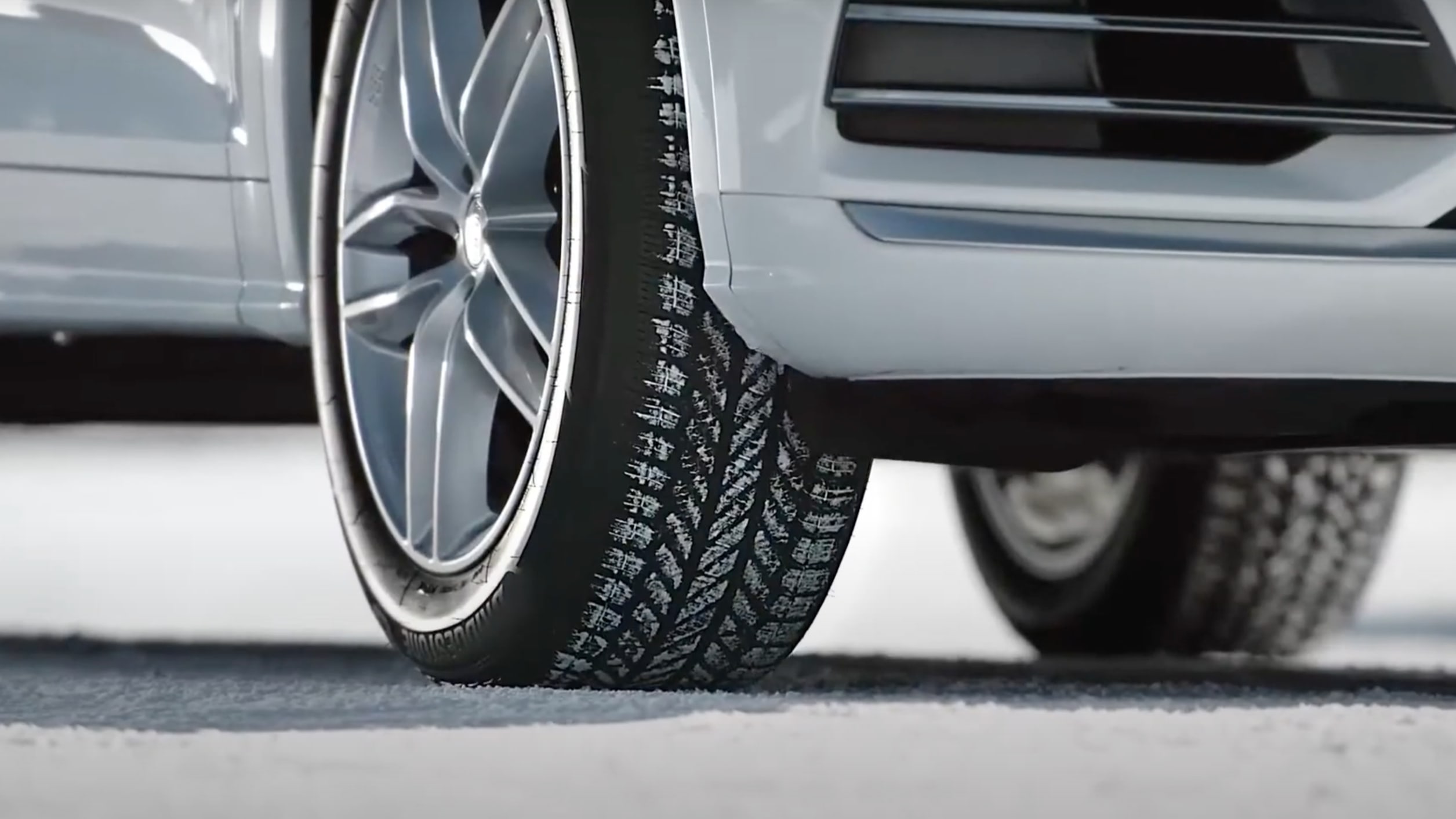
Here are some of SimpleTire’s top picks in the all-weather category:
Bridgestone Weatherpeak:
All-weather tires are designed for an advantage in winter traction and control, and with that performance goal in mind, Bridgestone engineers wanted to be dead sure that the Weatherpeak’s tread can deliver consistent grip in winter weather. The all-weather tread pattern is designed with a dense network of sipes, the hair-thin slits that add hundreds of extra biting edges to multiply the tread’s surface area and give drivers the advantage they need. The sipe design of the Weatherpeak has a unique 3D depth that continues to boost your winter grip and control even as the miles pile up and tread depth gets shallower. It’s an especially welcome feature since worn tread usually is synonymous with poorer traction with just about any tire. Another Bridgestone innovation is Weatherpeak’s “snow vices”, grooves that trap and retain snow to build snow-to-snow friction and enhance winter grip. Not surprisingly, the Bridgestone Weatherpeak is certified with the Three Peak Mountain Snowflake rating for severe winter service. Testing shows improved performance in braking, with the Weatherpeak being capable of braking distances that are as much as 30 feet shorter than the competition’s tires.
Our team took all this into account and noted a SimpleScore of 9.7 for traction for the Bridgestone Weatherpeak. SimpleScore for handling comes in at a very respectable 9.5, thanks to its tread design and rubber formulation. Steering response and cornering are also top-notch with a road feel that’s direct but never overly sensitive or touchy. Road manners, steering response, and cornering ability are also quite good with this tire, regardless of weather and road conditions. Our SimpleScore for longevity gives this tire a best-in-class 9.8 and Bridgestone covers the Weatherpeak with a 70,000 mile limited manufacturer’s tread life warranty.
Goodyear Assurance WeatherReady 2:
Goodyear’s innovation with the Assurance WeatherReady 2 starts from the ground up with an environmentally sustainable, silica-rich, soy-based compound that’s designed to offer dependable traction and long, even wear. Looking beneath the tread, you’ll find two wide steel belts that reinforce a single-ply polyester casing, with a polyamide cap ply layer designed for high-speed stability, comfort, and quick, light steering response. For year-round traction, the Assurance WeatherReady 2 is designed with a system that includes outboard ribs for traction on wet or snowy roads, Goodyear’s 3D TredLock Technology Blades, and specially designed sipes in the tread’s center. When the tire begins to wear down and tread depth becomes shallower, Evolving Traction Grooves keep providing traction. Sweeping Tread Grooves and the tire’s circumferential grooves work as a system, evacuating water from the tire’s contact patch and resisting the tendency to hydroplane. Snow and slush traction are enhanced with Zigzag Biting Edges along the tire’s inboard ribs, earning the Goodyear Assurance WeatherReady the tire industry’s Three Peak Mountain Snowflake certification for severe winter service.
Goodyear backs the Assurance WeatherReady with a 60,000 mile limited manufacturer tread life warranty. SimpleScores for the Goodyear Assurance WeatherReady 2 are 9.0 for traction, 9.0 for handling, 9.2 for longevity, and an overall 9.0, and SimpleTire’s prices on this tire range from $189.99/tire to $349.99/tire.
Falken Aklimate:
With the Aklimate, the Falken design team’s goals were to offer the ride quality, capable handling, low noise, and exemplary road manners of a Grand Touring tire, except with more of a focus on excellent traction and control on wet or snowy roads. The Aklimate is designed around a revamped tread formulation (utilizing their award-winning Advanced 4D Nano Design Technology), a next-generation rubber compound with great wear properties, low rolling resistance for a boost in fuel efficiency, and safe, consistent grip in wet or wintry conditions. The Falken Aklimate has the 3 Peak Mountain Snowflake rating for severe winter service.
On wet roads, the Aklimate is right in its element, with Falken’s innovative Canyon Groove design helping to resist hydroplaning by routing standing water away from the tire’s contact patch (SimpleScore for traction: a very strong 8.6). In standing water, snow, slush, or rain, 3D Canyon Sipes slice their way through those kinds of road conditions for dependable grip. Its sipe pattern, internal structure, and tread design all give the Aklimate’s tread face and shoulders extra stiffness, enough for a SimpleScore of 8.6 for handling. With a 65,000 mile limited manufacturer’s tread life warranty, we give it very strong longevity SimpleScore of 9.7, the Aklimate is a tire that drivers can count on for a long, long time. SimpleTire’s price on the Falken Aklimate goes from $95/tire to $281/tire.
General AltiMAX 365 AW:
What makes the General Altimax 365AW a great performer? It features a silica-rich tread formulation that’s engineered to keep its flexibility at subfreezing temperatures for winter traction, with General’s innovative Sinusoidal Siping System, Waved Grooves, and additional traction teeth in the tread to dig into snow and slush. The Altimax 365AW has the 3 Peak Mountain Snowflake rating for severe winter service. The sipe density is a bit less dense toward the tread’s center ribs for improved steering feedback and road feel, with the added benefit of helping to keep highway noise to a minimum.
Like other tires in the General product lineup, the Altimax 365AW is also equipped with Visual Alignment Indicators, giving a driver a heads-up to premature tire wear caused by wheel alignment that’s out of spec. General stands by the Altimax 365AW with a 60,000 mile manufacturer’s treadwear warranty. With an average SimpleScore of 9.0 out of 10, the General Altimax 365AW offers excellent handling (9.0), longevity (9.0), and traction (9.2). SimpleTire’s price on the AltiMAX 365AW runs from $112.99/tire to $240.99/tire.
What are Winter tires?
When the subject turns to winter tires, that’s a whole different matter. Winter tires are a specialized design all the way around and don’t have a lot in common with either all-season or all-weather tires. One of the biggest contrasts is the tread formulation of winter tires; all-season tires tend to stiffen up and lose traction in subfreezing weather, while the softer, more pliable rubber compound of winter tires stays flexible in extreme cold to deliver good grip (think about a hard rubber hockey puck vs a soft, flexible snow boot sole). The big drawback of that rubber compound is that these tires will also wear quickly on warmer days, and tire manufacturers (and warranties) recommend dismounting them and exchanging them for all-season tires when temperatures are above 40-45 degrees Fahrenheit.
Winter tires also have a much more aggressive tread design and sipe pattern, sometimes with a directional tread of V-shaped grooves that help move water and slush away from the tire’s contact patch. Some winter tire technologies also develop snow-to-snow friction; it might seem counterintuitive, but they’re designed with grooves that trap and retain snow rather than shedding it from the tread. Their tread compounds are also hydrophilic, meaning they attract water for improved grip on wet pavement. They may be infused with silica, cellulose, and other compounds that soak up water from the pavement on contact.
Studded vs non-studded
When ice storms hit and leave roads slicker than a hockey rink, even the best winter tires and all-weather tires are probably not going to be what you need to get around safely. That’s when studded tires are about the only thing that will get the job done.
Studded tires have plastic or metal studs embedded into the tread blocks at strategic points; the metal might be super-hard titanium, tungsten carbide, or other alloys that won’t corrode after contact with winter road chemicals. Like metal cleats or hobnails on a pair of boots, the studs bite into ice to develop traction and control, even on ice that’s an inch or two thick. Studded tires have some real drawbacks, including the fact that they’re very noisy and are better suited for lower speeds. They also tend to chew up pavement surfaces, which is why studded tires are banned by law in many states and are only legal during certain months in other states. An alternative is studdable tires, which come from the factory pre-drilled with holes so they can easily be pinned with studs by a qualified tire tech, then the studs can be removed again after the roads clear up.
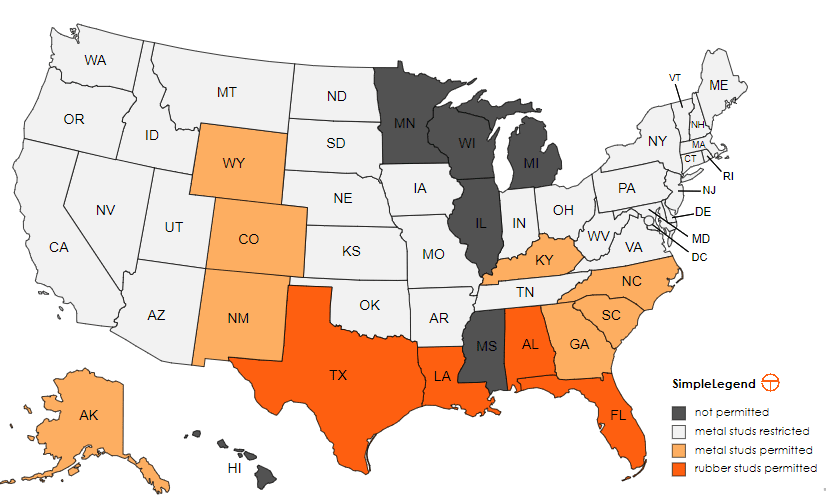
Top winter tire choices
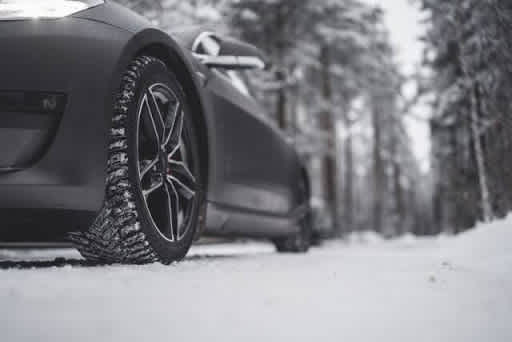
Here are some of SimpleTire’s top choices in the winter tire category:
Nokian Hakkapeliitta 10:
Nokian is a Finnish company with decades of experience in making tires for the harsh Scandinavian winter (“Hakkapeliitta” is Finnish for their 16th-century cavalry troops, and yes, Nokian has the same parent company as Nokia phones). The Hakkapeliitta 10 is a studdable winter tire – it’s pre-drilled for easy installation of studs in case of severe snow and ice (check your local and state laws for the legality of studded tires), and it has a stud pattern that’s optimized to help keep road noise to a minimum while delivering the best traction possible. Its winter tread design incorporates angled, sweeping grooves, a dense pattern of sipes, and a sticky, flexible winter rubber formulation for the most severe snow and slush, bringing in a SimpleScore of 9.9 for traction.
This tire gets the Three Peak Mountain Snowflake rating. The Nokian is very durable, with an Aramid-reinforced sidewall, tough internal construction, and an eco-friendly tread formulation that stays flexible in subfreezing weather (SimpleScore of 9.1 for longevity). We gave this tire an 8.9 for handling, largely thanks to its stiffer sidewalls that deliver great cornering without affecting ride quality. It's also worth pointing out that the Nokian Hakkapeliitta 10 SUV is designed for low rolling resistance, saving fuel over the tire’s service life. SimpleTire’s price on the Nokian Hakkapeliitta 10 runs from $146.99/tire to $631.99/tire.
Bridgestone Blizzak DM-V2:
The Blizzak DM-V2 has the technology and design features to get you from point A to point B in some of the most challenging winter conditions without subjecting you and your passengers to a slippery, treacherous, nerve-wracking ride. Bridgestone loaded up this purpose-built winter tire with next-generation innovations like an advanced winter tread formulation for flexibility at subfreezing temperatures and includes Bridgestone’s multi-cell rubber compounds and a hydrophilic coating. The Blizzak’s footprint is optimized to put the most rubber in contact with the road, with a redesigned set of block edges in its tread pattern. Its tread compound is embedded with “bite particles” so that the Blizzak DM-V2 gets the best purchase on snowy, slushy, or icy surfaces, earning a SimpleScore of 9.7 for traction. That enhanced contact patch means a noticeable improvement in steering feedback and response as well as traction and control, which translates to a SimpleScore of 8.9 for handling.
Durability is another strong hand with this tire; while most tires will have compromised traction as they wear down, Bridgestone designed the first 55% of the tire’s tread depth with NanoPro Tech Multicell Compound. When that wears down, the remaining 45% of tread depth that’s left is a standard winter compound that still offers excellent grip on snow and slush (SimpleScore of 9.3 for longevity). The Bridgestone Blizzak DM-V2 is Three Peak Mountain Snowflake certified and SimpleTire’s price on this tire ranges from $139.98/tire to $353.99/tire.
Continental VikingContact 7:
The VikingContact 7 uses a tread formulation that’s infused with silica and canola oil to stay pliable in subfreezing weather, with a winter tread pattern of cross-hatched grooves, snow grooves that trap and hold onto snow for better friction, interlocking sipes for improved grip and control in snow, ice, and slush, and wider grooves to divert water and slush away and resist hydroplaning. All of that adds up to a near-perfect SimpleScore of 9.9 for traction. That tread pattern is linked together with interlocked block bridges for better rigidity and control, which gives it a SimpleScore of 9.0 for handling. Though the VikingContact 7 doesn’t have a mileage warranty (most winter tires don’t), our team gives it a SimpleScore of 8.0 for longevity. Unsurprisingly, the Continental VikingContact 7 is Three Peak Mountain Snowflake rated for severe winter service. SimpleTire’s price on the Continental VikingContact 7 runs from $113.99/tire to $361.99/tire.
Hankook Winter i* Pike X (W429A):
The Hankook Winter i* Pike X (W429A) is a robust, new-age winter tire specifically engineered for the power, torque, weight, and handling of CUVs, SUVs, and light trucks. This tire is a bit of a departure from the other tires in this roundup, as it’s pre-drilled for the installation of studs. The W429A is designed for performance on icy, snowy, and wet roads, with improved wear properties and excellent control and grip. Its 2-in-1 shoulder blocks, and claw edges deliver tenacious traction on slippery surfaces, while wide center blocks and 3D sipe technology make the most of its grip and control. It’s designed with zigzag grooves to effectively channel water, slush, and melting snow away from the tread, reducing the risk of hydroplaning.
The innovative “ice slit” tread feature provides superior traction on ice, and Ultra High Tensile steel belts give the Hankook strong durability and puncture resistance, contributing to the tire's longevity.
This tire can be pinned with TSMI #12 studs, where permitted by law, for extra traction in severe ice, slush, and snow. The Hankook Winter i* Pike X (W429A) is a great choice for all-around winter performance in some of the worst conditions, with SimpleScores of 8.5 for traction, 8.5 for handling, 9.0 for longevity, and 8.6 overall; SimpleTire’s price on the Hankook Winter i* Pike X (W429A) runs from $100.79/tire to $276.98/tire.
When to use All-Season tires
Do you live in an area that has a fairly mild climate and winters that get cold, but might see no more than a couple of inches of snow? If that’s the case, all-season tires will probably do you just fine. Like we said up at the top, all-season tires offer great handling and road manners, long wear, a quiet and refined ride, and good all-around grip and control in everything from summer heat to winter driving. Where they don’t excel, though, is the kind of winter conditions that might leave several inches of snow on the road for days or weeks at a time.
When to use All-Weather tires
It’s probably easiest to think of all-weather tires as a compromise that splits the difference between winter tires and all-season tires when it comes to performance and traction. All-weather tires have a distinct and marked advantage over all-season tires in winter driving, with tread patterns, tread compounds, groove depths, groove designs, and sipe patterns that are all intended just for that. That also means capable performance and handling in the other three seasons of the year, but you should probably check the tire’s specs and reviews carefully before buying as there might be some tradeoffs in longevity and limited manufacturer’s tread life coverage as well as braking performance and handling.
When to use Winter tires
Winter tires are something that you really should only opt for if you live in a place like New England, the upper Midwest, or Canada where there’s likely to be multiple rounds of winter storms and snow on the roads for the majority of the season. Winter tires are purpose-built for those kinds of conditions and can’t be used year-round; remember, they’ll wear prematurely when the temperatures warm up (which also will void the tire warranty). Winter tires typically do not come with a limited manufacturer’s tread life or mileage warranty, and when things warm up again you’ll need to have them dismounted and replaced with all-season tires, then you need to figure out a place to store them until the next winter.
Which one should you choose?
This is when it really comes down to your vehicle, your needs, and most importantly, your weather and climate. Does it snow a lot where you are, and you don’t feel safe driving on the roads with all-season tires under your vehicle? Go with winter tires and dismount them again when things warm up.
Do you have winters that might leave a few inches of snow on the road for a few days or a week at a time? All-weather tires will probably get the job done for you just fine.
Do you put a premium on ride quality, longevity, handling, low noise, and traction, but you live in an area with relatively mild winters, for instance, the southern United States? All-season tires are going to be a perfectly capable option.
If you have doubts about which tires are going to be the best choice for you, SimpleTire’s agents will be happy to consult with you and help you through the decision process. Regardless of what you opt for in the end, we’re confident that SimpleTire will have a set of all-season, all-weather, or winter tires that’ll be the right fit for your vehicle, your needs, and your budget!
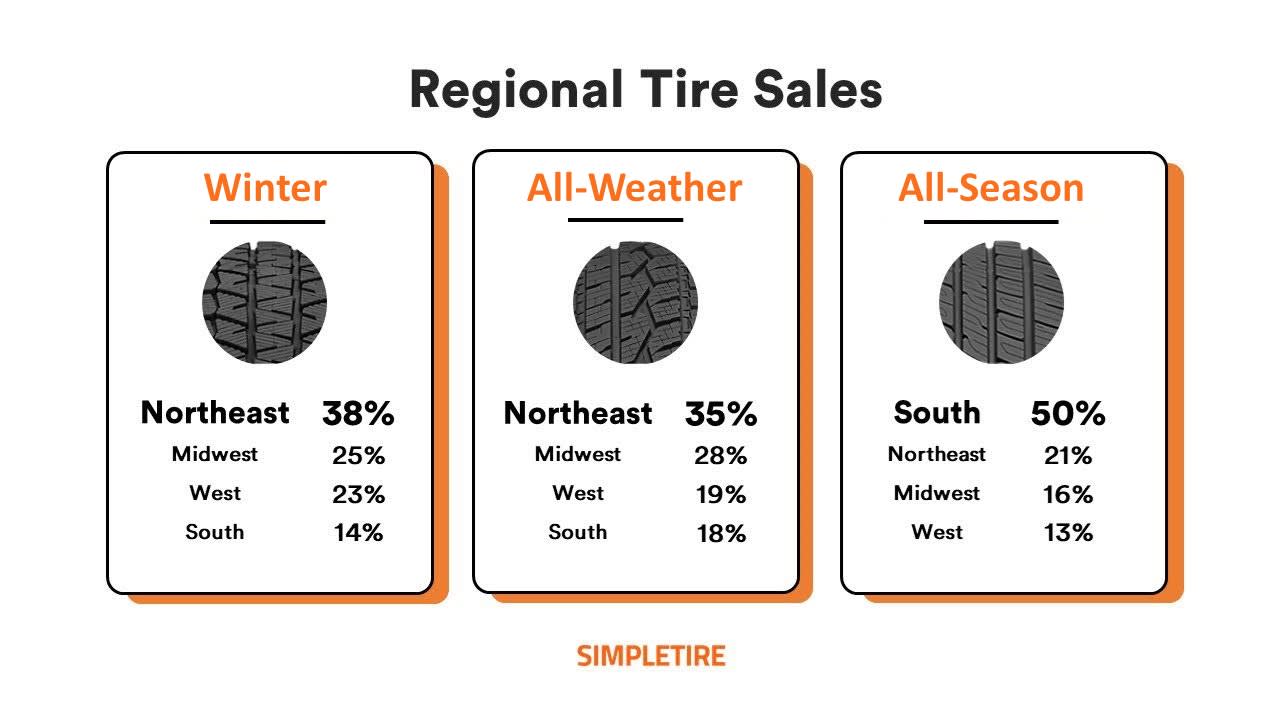
Ready to find the perfect tires?
Search By